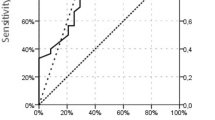Abstract
Objectives
To determine the clinical, laboratory, and imaging variables that can predict spontaneous stone passage in patients with renal colic secondary to ureteral calculi.
Methods
We prospectively analyzed the medical records of 114 patients who admitted to the emergency department for renal colic from June until November of 2010. Forty-six of them were excluded. The presence of ureteral calculi was confirmed by either a kidney-ureter-bladder plain film or an ultrasound or a computer tomography. In all patients, a second visit after 1 month was planned and the stone status was checked by the same imaging techniques.
Results
From the 68 patients, 16 had a calculus in the upper ureter, 10 in the mid ureter, and 42 in lower part. Stone size was ranged from 2.3 to 15 mm, 52.9% of them were located in the left ureter and 51.5% were radiopaque. Stones passed spontaneously in 36 patients. In multivariate analysis, serum white blood cell count found to be the most significant predictor (P = 0.028) for spontaneous passage followed by stone size (P = 0.037). In analysis of patients with stone size <10 mm, left side (P = 0.017) and serum white blood cell count (P= 0.032) found to be significant predictors.
Conclusions
Serum white blood cell count is an easy to assay variable in everyday practice. This study showed that its value, at the acute phase of a renal colic, is a significant predictor for stone spontaneous passage and should be considered. Stone size remains a valuable predictor. Stones <10 mm on the left ureter have a higher likelihood to pass spontaneously.
Similar content being viewed by others
References
Stamatelou KK, Francis ME, Jones CA et al (2003) Time trends in reported prevalence of kidney stones in the United States: 1976–1994. Kidney Int 63:1817–1823
Romero V, Akpinar H, Assimos DG (2010) Kidney stones: a global picture of prevalence, incidence, and associated risk factors. Rev Urol 12:86–96
Meschi T, Maggiore U, Fiaccadori E et al (2004) The effect of fruits and vegetables on urinary stone risk factors. Kidney Int 66:2402–2410
Taylor EN, Curhan GC (2007) Oxalate intake and the risk for nephrolithiasis. J Am Soc Nephrol 18:2198–2204
Sierakowski R, Finlayson B, Landes RR et al (1978) The frequency of urolithiasis in hospital discharge diagnoses in the United States. Invest Urol 15:438–441
Parekattil SJ, Kumar U, Hegarty NJ et al (2006) External validation of outcome prediction model for ureteral/renal calculi. J Urol 175:575–579
Skolarikos A, Laguna MP, Alivizatos G et al (2010) The role for active monitoring in urinary stones: a systematic review. J Endourol 24:923–930
Hubner WA, Irby P, Stoller ML (1993) Natural history and current concepts for the treatment of small ureteral calculi. Eur Urol 24:172–176
Preminger GM, Tiselius HG, Assimos DG et al (2007) American Urological Association Education and Research, Inc; European Association of Urology. 2007 Guideline for the management of ureteral calculi. Eur Urol 52:1610–1631
Segura JW, Preminger GM, Assimos DG et al (1997) Ureteral stones clinical guidelines panel summary report on the management of ureteral calculi. The American Urological Association. J Urol 158:1915–1921
Morse RM, Resnick MI (1991) Ureteral calculi: natural history and treatment in an era of advanced technology. J Urol 145:263–265
Coll DM, Varanelli MJ, Smith RC (2002) Relationship of spontaneous passage of ureteral calculi to stone size and location as revealed by unenhanced helical CT. AJR Am J Roentgenol 178:101–103
Miller OF, Kane CJ (1999) Time to stone passage for observed ureteral calculi: a guide for patient education. J Urol 162:688–690
Ibrahim AI, Shetty SD, Awad RM et al (1991) Prognostic factors in the conservative treatment of ureteric stones. Br J Urol 67:358–361
Geavlete P, Georgescu D, Cauni V et al (2002) Value of duplex Doppler ultrasonography in renal colic. Eur Urol 41:71–78
Takahashi N, Kawashima A, Ernst RD et al (1998) Ureterolithiasis: can clinical outcome be predicted with unenhanced helical CT? Radiology 208:97–102
Author information
Authors and Affiliations
Corresponding author
Rights and permissions
About this article
Cite this article
Sfoungaristos, S., Kavouras, A. & Perimenis, P. Predictors for spontaneous stone passage in patients with renal colic secondary to ureteral calculi. Int Urol Nephrol 44, 71–79 (2012). https://doi.org/10.1007/s11255-011-9971-4
Received:
Accepted:
Published:
Issue Date:
DOI: https://doi.org/10.1007/s11255-011-9971-4




